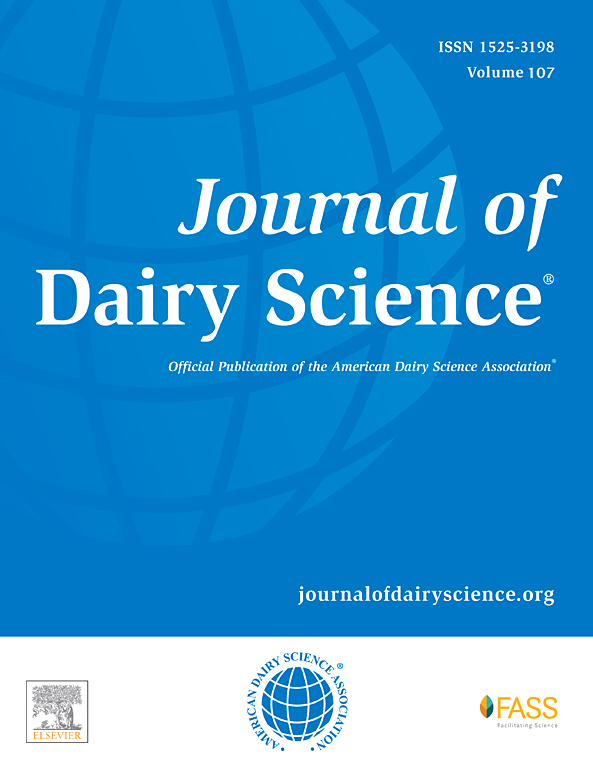The microbiota of ensiled forages and of bulk tank milk on dairy cattle farms in northern Sweden
IF 3.7
1区 农林科学
Q1 AGRICULTURE, DAIRY & ANIMAL SCIENCE
引用次数: 0
Abstract
Factors contributing to variations in the quality and microbiota of ensiled forages and in bulk tank microbiota in milk from cows fed different forages were investigated. Nutritional quality, fermentation parameters and hygiene quality of forage samples and corresponding bulk tank milk samples collected in 3 periods from 18 commercial farms located in northern Sweden were compared. Principal coordinates analysis revealed that the microbiota in forage and bulk milk, analyzed using 16S rRNA gene-based amplicon sequencing, were significantly different. The genera Lactobacillus, Weissella, and Leuconostoc dominated in forage samples, whereas Pseudomonas, Staphylococcus, and Streptococcus dominated in bulk milk samples. Forage quality and forage-associated microbiota were affected by ensiling method and by use of silage additive. Forages stored in bunker and tower silos (confounded with use of additive) were associated with higher levels of acetic and lactic acid and Lactobacillus. Forage ensiled as bales (confounded with no use of additive) was associated with higher DM content, water-soluble carbohydrate content, pH, yeast count, and the genera Weissella, Leuconostoc, and Enterococcus. For bulk tank milk samples, milking system was identified as the major factor affecting the microbiota and type of forage preservation had little effect. Analysis of common amplicon sequence variants (ASV) suggested that forage was not the major source of Lactobacillus found in bulk tank milk.
瑞典北部奶牛场贮藏饲草和散装罐装牛奶中的微生物群--一项案例研究。
本研究调查了导致饲喂不同饲草的奶牛所产牛奶中沼渣饲草的质量和微生物群以及散装牛奶中微生物群变化的因素。研究人员比较了从瑞典北部 18 个商业牧场采集的 3 个时期的饲草样本和相应的散装牛奶样本的营养质量、发酵参数和卫生质量。主坐标分析表明,通过基于 16S rRNA 基因的扩增子测序分析,饲草和散装牛奶中的微生物群存在显著差异。草料样本中主要是乳酸杆菌属、魏氏菌属和白念珠菌属,而散装牛奶样本中主要是假单胞菌属、葡萄球菌属和链球菌属。饲草质量和饲草相关微生物群受贮藏方法和青贮添加剂的影响。贮存在仓式青贮窖和塔式青贮窖中的饲草(与添加剂的使用相混淆)与较高水平的乙酸、乳酸和乳酸杆菌有关。以草捆贮存的饲草(与不使用添加剂相混淆)干物质含量、水溶性碳水化合物含量、pH 值、酵母计数以及魏氏菌属、白色念珠菌属和肠球菌属较高。对于散装罐装牛奶样本,挤奶系统被认为是影响微生物群的主要因素,而饲草保存类型对其影响不大。常见扩增片段序列变异(ASV)分析表明,饲草不是散装牛奶中乳酸菌的主要来源。
本文章由计算机程序翻译,如有差异,请以英文原文为准。
求助全文
约1分钟内获得全文
求助全文
来源期刊

Journal of Dairy Science
农林科学-奶制品与动物科学
CiteScore
7.90
自引率
17.10%
发文量
784
审稿时长
4.2 months
期刊介绍:
The official journal of the American Dairy Science Association®, Journal of Dairy Science® (JDS) is the leading peer-reviewed general dairy research journal in the world. JDS readers represent education, industry, and government agencies in more than 70 countries with interests in biochemistry, breeding, economics, engineering, environment, food science, genetics, microbiology, nutrition, pathology, physiology, processing, public health, quality assurance, and sanitation.
 求助内容:
求助内容: 应助结果提醒方式:
应助结果提醒方式:


